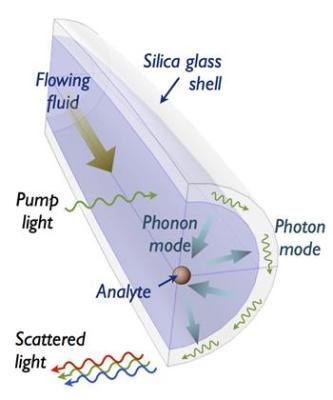Jun 7 2016
A novel technique has been developed by scientists from the University of Illinois at Urbana-Champaign where an opto-mechano-fluidic resonator (OMFR) is used for detecting ultra-high speed photonic sensing of the mechanical properties of free flowing particles. This study brings about entirely new mechanical “axes of measurement” on bioparticles and micro/nanoparticles.
 OMFRs employ phonons (quasiparticles of sound and vibration) to engage the conversation between the flowing analyte particles and circulating photons (particles of light) in the silica glass shell. In doing so, they make light sensitive to the mechanical parameters of the analyte. (Credit: University of Illinois)
OMFRs employ phonons (quasiparticles of sound and vibration) to engage the conversation between the flowing analyte particles and circulating photons (particles of light) in the silica glass shell. In doing so, they make light sensitive to the mechanical parameters of the analyte. (Credit: University of Illinois)
For routine analysis of large populations of particles, high-speed optical detection methods, like flow cytometry are used. These methods are used for measuring the optical properties of particles having analysis speeds of around 50,000 particles/s. The mechanical properties of the particles like mass, compressibility, stiffness, density, etc. cannot be measured directly by optical sensors. Till date, the routine measurements on large cell populations have not been practical since the mechanical sensors have not come near the speed of optical flow cytometers.
“It is known that diseases such as cancers and anemia can correlate with mechanical properties of cells such as compressibility and viscoelasticity, but these properties are not used diagnostically due to absence of tools with enough speed and sensitivity to perform the measurement,” explainedGaurav Bahl, an assistant professor ofmechanical science and engineering at Illinois. “Because of this, we have a substantial knowledge-gap, and have barely scratched the surface of understanding of how diseases modify the mechanical properties of cells in our body. Developing knowledge around the mechanics of cells and bioparticles can help us understand the mobility of these micro-objects throughout the human body, about how tumors form, about how cells and bacteria can propagate through us, how diseases spread, and more.
In this study, we aimed to blend the best features of optical sensing, i.e. the extremely high bandwidth and sensitivity, with mechanical sensing which gives us the ability to measure mechanical properties. To achieve this, we have developed a new microfluidic opto-mechanical device that optically detects the mechanical perturbations created by individual microparticles flowing through the fluidic channel at very high speed.
Kewen Han, a doctoral candidate and first author of the paper in the Optica, June 2016 edition
The scientists investigated the particle-sensing abilities of the OMFR using two kinds of microbeads and bakers’ yeast.
The OMFR’s multimode sensing capability permits measurement of multiple particles with redundancy, and indicates future potential for inertial imaging.The system also detects mechanical energy loss associated with individual particles, likely related to viscoelastic properties of the soft material and boundary loss at interface of particle and liquid.
Kewen Han
“We have shown that our technique is sensitive to the density and compressibility of each individual particle as it passes by,” Bahl said. “The smallest detectable particle as reported in this work is around 660 nm.
“This work presents a new approach to perform resonantly enhanced optical sensing of freely flowing particles through the action of long-range phonons that extend between solid and fluid phases of the sensor and sample.”
The paper titled, “High-throughput sensing of freely flowing particles with optomechanofluidics,” is available online. The National Science Foundation grants ECCS-1509391 and ECCS-1408539 supported the research.